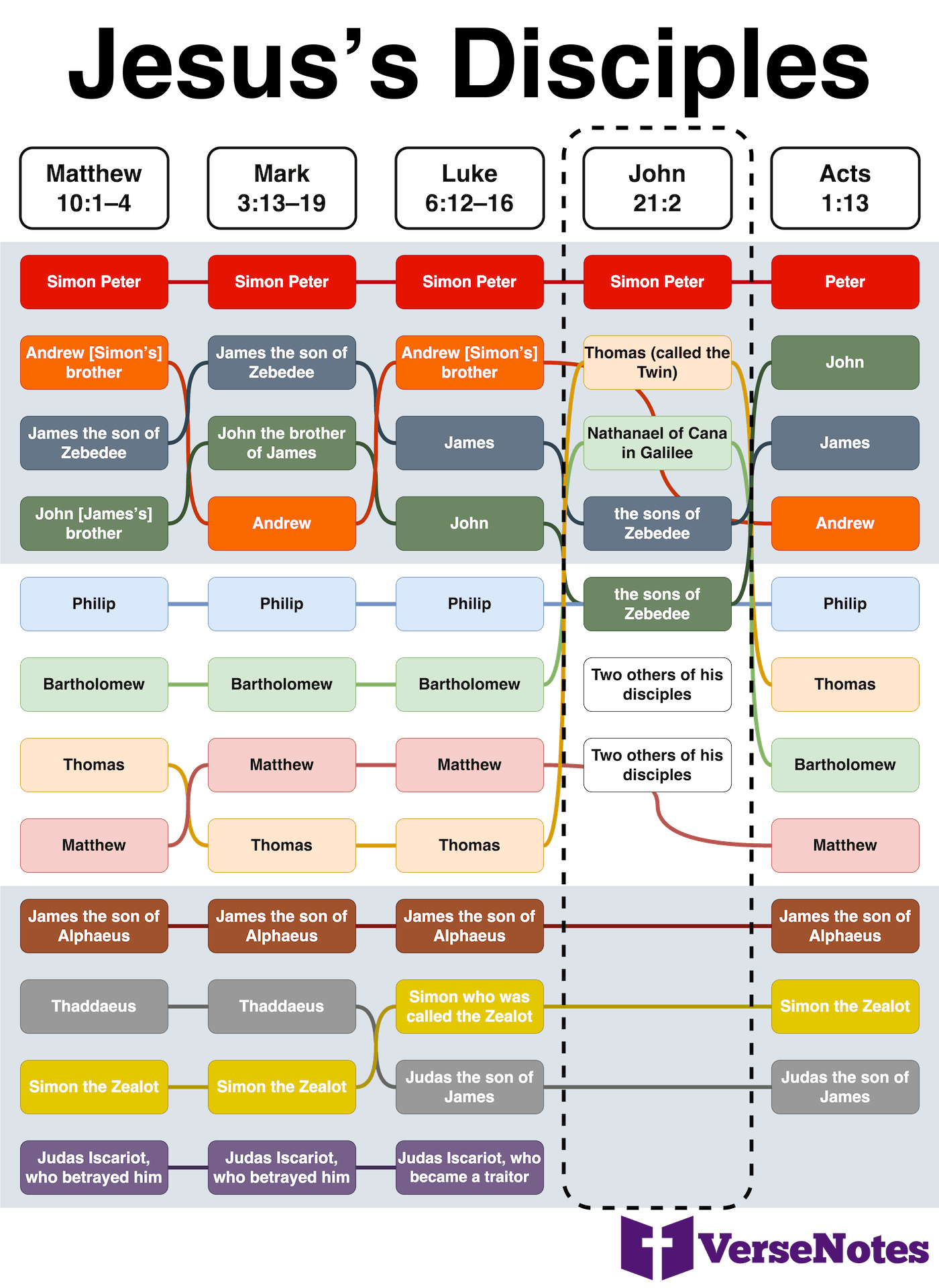Fishing for Men: Naming Jesus’s Disciples
This post is part of the series “Fishing for Men”
-
Fishing for Men: Naming Jesus’s Disciples 👈 you are here
-
Fishing for Men: Calling Jesus’s Disciples
We all know Jesus had twelve disciples. But when you try to write down their names, you run into a problem: the New Testament actually lists fourteen names!
I believe in the consistency of Scripture, and I definitely believe that twelve is the correct number (among other reasons, it matches the number of tribes of Israel). So I went hunting for the answer to this mystery.
As usual when faced with a Bible question, I started with a broad search of Scripture itself. It turns out the New Testament lists the disciples five times: once each in Matthew, Mark, Luke, John, and Acts. How convenient! Here are the lists:
| Matthew 10:1-4 | Mark 3:13-19 | Luke 6:12-16 | John 21:2 | Acts 1:13 |
|---|---|---|---|---|
| Simon, who is called Peter | Simon (to whom he gave the name Peter) | Simon, whom he named Peter | Simon Peter | Peter |
| Andrew [Simon’s] brother | James the son of Zebedee | Andrew [Simon’s] brother | Thomas (called the Twin) | John |
| James the son of Zebedee | John the brother of James | James | Nathanael of Cana in Galilee | James |
| John [James’s] brother | Andrew | John | the sons of Zebedee | Andrew |
| Philip | Philip | Philip | 〃 | Philip |
| Bartholomew | Bartholomew | Bartholomew | Two others of his disciples | Thomas |
| Thomas | Matthew | Matthew | 〃 | Bartholomew |
| Matthew the tax collector | Thomas | Thomas | Matthew | |
| James the son of Alphaeus | James the son of Alphaeus | James the son of Alphaeus | James the son of Alphaeus | |
| Thaddaeus | Thaddaeus | Simon who was called the Zealot | Simon the Zealot | |
| Simon the Zealot | Simon the Zealot | Judas the son of James | Judas the son of James | |
| Judas Iscariot, who betrayed him | Judas Iscariot, who betrayed him | Judas Iscariot, who became a traitor |
In the table, I’ve transcribed exactly what the author calls each man to make sure we don’t get James and James confused, or Judas and Judas, or Simon and Simon.
We note a few things immediately. The first is that John’s list is totally different from the other four; I suppose we should expect that of John. There’s a reason the other three are called “synoptic1,” and Luke wrote Acts, so it’s reasonable that we get four similar lists and one… John.
The second thing we notice is that the list in Acts has only eleven names. That’s also reasonable, because by that point in the story (Acts 1:13), Judas Iscariot has betrayed Jesus and later killed himself, but the disciples don’t choose Matthias as a replacement until Acts 1:26.
Finally, we notice that the lists of names are very similar—but not the same—and the orders of the names are similar—but not the same.
All five lists start with Simon Peter, and they all include also Thomas, James the son of Zebedee, and John the son of Zebedee. The three synoptic lists and Acts all include Simon Peter, Andrew, James, John, Philip, Bartholomew, Thomas, Matthew, James the son of Alphaeus, and Simon the Zealot (sometimes called Simon Zealotes). The three synoptic lists (but not Acts) all include Judas Iscariot, as previously explained.
Luke and Acts further include Judas the son of James, and John adds Nathanael of Cana in Galilee.
So now we have fourteen names to match to twelve disciples. But before we move on to that task, let’s keep looking at those lists.
If you stare long enough, you realize that even though the order of the lists is jumbled, the structures in Matthew, Mark, Luke, and Acts are surprisingly similar:
- The first four always include Simon Peter, his brother Andrew, and James and John, the sons of Zebedee. They always start with Simon Peter.
- The second four always include Philip, Bartholomew, Thomas, and Matthew. They always start with Philip.
- The third four always include James the son of Alphaeus, Simon the Zealot, and Judas Iscariot (except Acts). They always start with James the son of Alphaeus.
Not only is this structure intriguing and delightful, but it also immediately solves one problem for us: the person Matthew and Mark call “Thaddaeus” is almost definitely the same person that Luke and Acts call “Judas the son of James”. John MacArthur in his book Twelve Ordinary Men suggests that the man’s given name was Judas, and Thaddaeus—meaning “breast-child”—was a nickname2.
So there’s only one question left: Who is Nathanael?
Well, his origins don’t help; they’re all Galilean. But just as “Thaddaeus” feels like a nickname because of what it means, another name on the list suggests that it’s not the man’s given name either. Before moving on, see if you can guess which name it is based on its similarity to other Biblical names.
I’ll wait.
If you remove Thaddaeus, all of the other listed names are common enough first-century first names except Bartholomew. That name actually means “son of Tolmai,” suggesting that it’s not what his mother called him unless she was angry. So that’s the apostle most likely to have another name; a different author might have written “Nathanael the son of Tolmai” just as these guys wrote “Judas the son of James” and “James the son of Alphaeus.”
Now that we’ve equated Thaddaeus with Judas the son of James and Bartholomew with Nathanael, we’re back down to twelve names, which is where we started and what we expected.
In the next article, we’ll look at how Jesus called His disciples, going fishing for fishermen to make them fishers of men.

This post is part of the series “Fishing for Men”
-
Fishing for Men: Naming Jesus’s Disciples 👈 you are here
-
Fishing for Men: Calling Jesus’s Disciples



